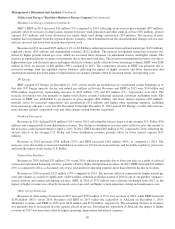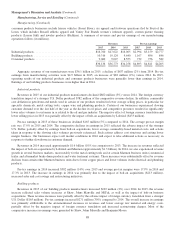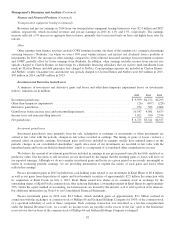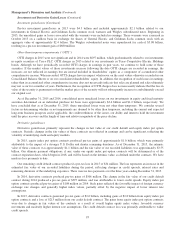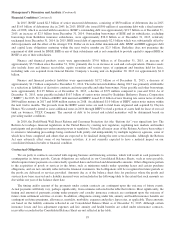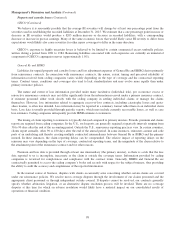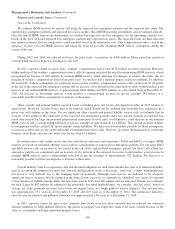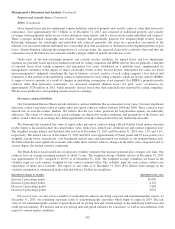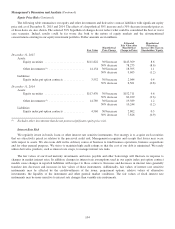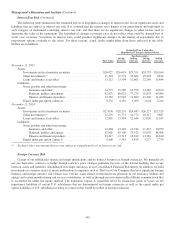Berkshire Hathaway 2015 Annual Report Download - page 97
Download and view the complete annual report
Please find page 97 of the 2015 Berkshire Hathaway annual report below. You can navigate through the pages in the report by either clicking on the pages listed below, or by using the keyword search tool below to find specific information within the annual report.Management’s Discussion and Analysis (Continued)
Financial Condition (Continued)
In 2015, BNSF issued $2.5 billion of senior unsecured debentures, consisting of $850 million of debentures due in 2025
and $1.65 billion of debentures due in 2045. In 2015, BNSF also issued $500 million of amortizing debt with a final maturity
date of 2028, which is secured with locomotives. BNSF’s outstanding debt was approximately $21.7 billion as of December 31,
2015, an increase of $2.5 billion from December 31, 2014. Outstanding borrowings of BHE and its subsidiaries, excluding
borrowings from Berkshire insurance subsidiaries, were approximately $36.0 billion as of December 31, 2015, relatively
unchanged from December 31, 2014. In 2015, BHE issued debt of approximately $2.5 billion which was substantially offset by
debt repayments and the effect of the stronger U.S. Dollar on its non-dollar denominated debt. BNSF and BHE aggregate debt
and capital lease obligations maturing within the next twelve months are $2.5 billion. Berkshire does not guarantee the
repayment of debt issued by BNSF, BHE or any of their subsidiaries and is not committed to provide capital to support BHE or
BNSF or any of their subsidiaries.
Finance and financial products assets were approximately $39.0 billion as of December 31, 2015, an increase of
approximately $5.5 billion since December 31, 2014, primarily due to an increase in cash and cash equivalents. Finance assets
also include loans and finance receivables, equity securities and various types of equipment and furniture held for lease,
including tank cars acquired from General Electric Company’s leasing unit on September 30, 2015 for approximately $1.0
billion.
Finance and financial products liabilities were approximately $17.2 billion as of December 31, 2015, a decrease of
approximately $1.7 billion compared to December 31, 2014. The reduction in liabilities during 2015 was primarily attributable
to a reduction in liabilities of derivative contracts and notes payable and other borrowings. Notes payable and other borrowings
were approximately $11.95 billion as of December 31, 2015, a decline of $779 million compared to year-end 2014. As of
December 31, 2015, notes payable included $10.7 billion of senior notes issued by Berkshire Hathaway Finance Corporation
(“BHFC”). In 2015, $1.5 billion of BHFC debt matured and BHFC issued $1.0 billion of new floating rate senior notes of which
$400 million mature in 2017 and $600 million mature in 2018. An additional $1.0 billion of BHFC senior notes mature within
the next twelve months. The proceeds from the BHFC senior notes are used to fund loans originated and acquired by Clayton
Homes. We currently intend to issue additional notes in 2016 through BHFC to fund a portion of assets held for lease of our rail
tank car business, UTLX Company. The amount of debt to be issued and related maturities will be determined based on
prevailing market conditions.
In 2010, the Dodd-Frank Wall Street Reform and Consumer Protection Act (the “Reform Act”) was signed into law. The
Reform Act reshapes financial regulations in the United States by creating new regulators, regulating new markets and market
participants and providing new enforcement powers to regulators. Virtually all major areas of the Reform Act have been subject
to extensive rulemaking proceedings being conducted both jointly and independently by multiple regulatory agencies, some of
which have been completed and others that are expected to be finalized during the next several months. Although the Reform
Act may adversely affect some of our business activities, it is not currently expected to have a material impact on our
consolidated financial results or financial condition.
Contractual Obligations
We are party to contracts associated with ongoing business and financing activities, which will result in cash payments to
counterparties in future periods. Certain obligations are reflected in our Consolidated Balance Sheets, such as notes payable,
which require future payments on contractually specified dates and in fixed and determinable amounts. Other obligations pertain
to the acquisition of goods or services in the future, such as minimum rentals under operating leases and certain purchase
obligations, and are not currently reflected in the financial statements. Such obligations will be recognized in future periods as
the goods are delivered or services provided. Amounts due as of the balance sheet date for purchases where the goods and
services have been received and a liability incurred were not included in the following table to the extent that such amounts are
due within one year of the balance sheet date.
The timing and/or amount of the payments under certain contracts are contingent upon the outcome of future events.
Actual payments will likely vary, perhaps significantly, from estimates reflected in the table that follows. Most significantly, the
timing and amount of payments arising under property and casualty insurance contracts are contingent upon the outcome of
future claim settlement activities or events. In addition, obligations arising under life, annuity and health insurance benefits are
contingent on future premiums, allowances, mortality, morbidity, expenses and policy lapse rates, as applicable. These amounts
are based on the liability estimates reflected in our Consolidated Balance Sheet as of December 31, 2015. Although certain
insurance losses and loss adjustment expenses and life, annuity and health benefits are ceded under reinsurance contracts,
receivables recorded in the Consolidated Balance Sheet are not reflected in the table.
95



